Mila 18 in the Warsaw Ghetto
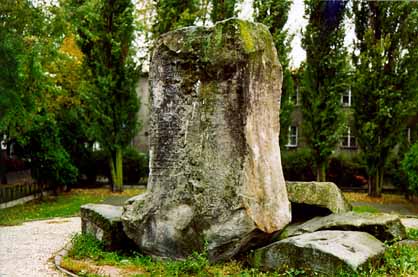 Memorial at Mila 18
honors Jewish heroes of Warsaw
Memorial at Mila 18
honors Jewish heroes of Warsaw
Pictured above is the memorial stone
to the Jewish heroes of the Z.O.B. (Jewish Fighting Organization)
who died in an underground bunker beneath the house at ul. Mila
18 during the Warsaw Ghetto Uprising in April and May 1943. The
stone sits on top of a mound of rubble, where the house at this
address once stood; it is turned slightly toward Mila street
which is to the left. The street is still named Mila, but #18
is no longer an address there.
When I visited Warsaw in 1998, my tour
guide told me that the Mila 18 bunker was the last one to be
destroyed in the Warsaw Ghetto Uprising; a book entitled "A
travel guide to Jewish Europe" by Ben G. Frank, which I
purchased later, mentions that Mila 18 was "the last bunker
of the Warsaw Ghetto Uprising."
The following quote is from the book
entitled "A Surplus of Memory" by Yitzhak Zuckerman,
one of the survivors of the Z.O.B.
The memorial to the Ghetto Uprising
was commissioned from the sculptor Nathan Rappoport after I left
Poland. Initially, we set up another memorial, a big stone on
the bunker of Mila 18. I gave a speech on behalf of the Jewish
community at the unveiling of the tombstone, along with a Polish
general on April 19, 1945.
Today there is nothing left of the house
at Mila 18. According to Martin Gilbert in his book entitled
"The Holocaust":
That September, the Germans sent a
Polish labour battalion to the site of the ghetto, to demolish
any walls and structures, still undestroyed. "Those who
still remained in hiding" one of the ghetto's most recent
historians has written, "evidently met their deaths during
the demolition activities, although a few individuals continued
to live in dug-outs, totally cut off from nature, light and human
company."
The Germans had planned to make the former
ghetto into a huge city park. Instead, the spot where Mila 18
once stood is now in the middle of a neighborhood of new modern
buildings.
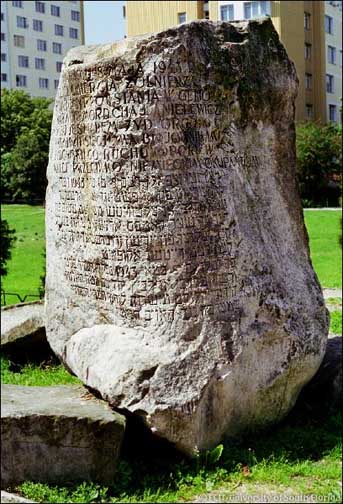 Mila 18 Stone is inscribed
with names of Jewish heroes
Photo credit: Florida
Center for Instructional Technology.
Mila 18 Stone is inscribed
with names of Jewish heroes
Photo credit: Florida
Center for Instructional Technology.
The memorial stone at Mila 18 has the
names of the leaders of the Warsaw Ghetto Uprising, including
Marek
Edelman, the longest living survivor, who died in 2009.
According to a book entitled "The
bravest battle, the 28 days of the Warsaw Ghetto," Mila
18 was a self-contained world-within-a world. A long narrow corridor
led into numerous underground rooms on either side. A gang of
thieves, led by Schmuel Asher, had previously excavated this
gigantic bunker under three large adjoining buildings. Asher
led Mordechai Anielewicz, the commander of the Z.O.B., to the
bunker.
The photograph below shows what the bunkers
under the buildings in the Warsaw Ghetto looked like. (This is
not a photo of the bunker at Mila 18.)
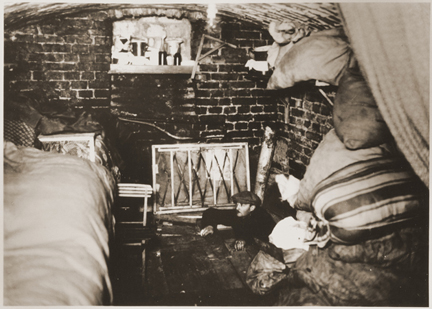
Jews in Warsaw Ghetto
hid in underground bunkers
Access to the bunker at Mila 18 was through
a house at that address. There were many other bunkers in the
Warsaw Ghetto and Mila 18 was the last of them to be destroyed
by the Germans. The fighting continued even after Mila 18 fell
and other houses that sheltered Jews, but did not have access
to a bunker, were attacked.
The attack on the Mila 18 bunker began on May 8, 1943, after
the fighting between SS soldiers and the Jews had been going
on for almost three weeks. The SS brought in Ukrainian and Latvian
auxiliary SS soldiers because they could not speak Polish or
Yiddish and thus could not be persuaded by the Jews to allow
them to escape, according to Martin Gilbert's book entitled "Holocaust
Journey."
For two hours, the Ukrainian and Latvian
SS soldiers bombarded the entrance to the house at Mila 18, and
then threw tear gas into the bunker to force the occupants out.
Unwilling to surrender, many of the resistance fighters took
their own lives. Mordechai Anielewicz, the leader of the Z.O.B.,
was holed up that day in the Mila 18 bunker, along with around
120 of his comrades and around 80 Jews who were not members of
the Z.O.B.
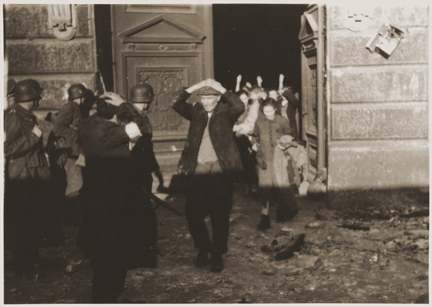 A family of Jews surrenders
to the SS soldiers
A family of Jews surrenders
to the SS soldiers
The battle of the Warsaw Ghetto finally
ended at 8:15 p.m. on May 16th when the German SS Commander,
Jürgen Stroop, declared victory by blowing up the Tlomacki
Synagogue outside the walls of the Ghetto. According to the Stroop
Report, around 5,000 to 6,000 Jews who were hiding in buildings
in the Ghetto were blown up or burned to death and a total of
631 bunkers were destroyed.
The following quote is from the book
entitled "The bravest battle: the twenty-eight days of the
warsaw ghetto":
As at Masada, where 2000 years earlier
a group of Jews decided to kill themselves rather than surrender
to the Romans, most of the 120 fighters at Mila 18 chose the
same solution, though it was not imposed on anyone. The more
than 80 civilians who remained would either surrender or die
of asphyxiation in the bunker.
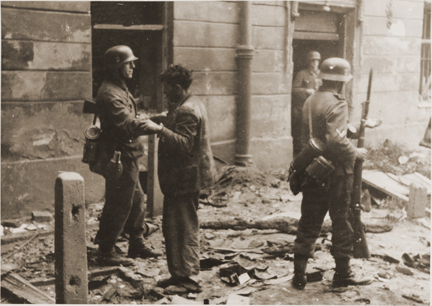 An SS soldier searches
a Jew captured during the fighting
An SS soldier searches
a Jew captured during the fighting
The old photos on this page were taken
by the SS and put into three photo albums by Jürgen Stroop,
the SS commander who led the fight against the Jewish resistance
movement. One of these photo albums is now stored in the National
Archives in Washington, DC.
The photograph below shows the spot on
Mila street where the house once stood. Beyond the trees in the
foreground, you can see the grass covered mound of rubble with
a memorial stone on the top of it.
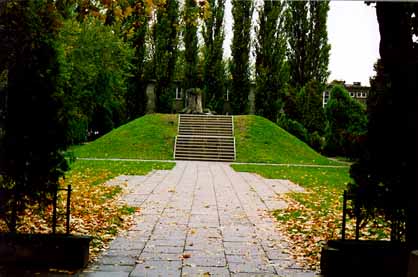 Path around mound shows
size of house at #18 Mila Street
Path around mound shows
size of house at #18 Mila Street
Just below the steps, in the photo above,
you can see a path around the mound. This path is an outline
of the actual building which stood at Mila 18. As you can see
by the size of the mound, the building was very small. The photo
above was taken from the street which is at right angles to Mila
street. The actual entrance to the house at number 18 Mila street
was formerly in the spot shown in the photo below. The house
was set very close to the street. A row of trees has been planted
where the sidewalk in front of the house used to be.
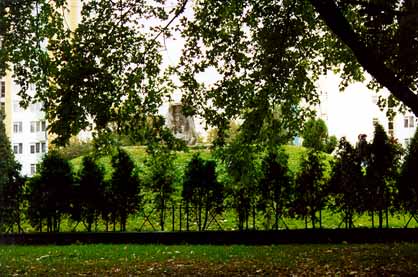 The former location
of house #18 on Mila Street in Warsaw
The former location
of house #18 on Mila Street in Warsaw
This page was last updated on October
10, 2009
|